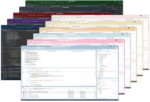The news that James Gosling, father of Java, was leaving Oracle was a big shock to the Java faithful. For years, Gosling has been the veritable Santa Claus of JavaOne, shaking hands and taking developers onto his lap to hear about what type of set-top box they want for Christmas. He’s been the ambassador for Java, Sun’s very own Richard Stallman or Donald Knuth, if you will.
So, when Gosling announced his early-April departure from Oracle, many reacted like their kids had witnessed the local mall cop throw Santa through the doors by the scruff of his neck.
Gosling’s departure is symbolic. It is indicative of the fundamental differences between the different approaches—and priorities—of Sun and Oracle. Oracle exists to sell expensive software, expensive hardware and expensive services. On the software side, Oracle’s products are huge databases, high-end application servers and costly business-management systems. Java represents a rounding error.
Make no mistake: Oracle is not “the Java company,” as Sun so greedily termed itself. Sun changed its stock symbol from SUNW (for Sun Workstations) to JAVA to send a message that its business was open-source software. Don’t expect Oracle to do the same; it is ORCL, a company that views open source as important, but not as its business model.
Oracle understands that Sun never made money for all of its work with Java. Despite 15 years of solid investment and feverish evangelism of open-source software, Sun was, at its heart, a hardware company. Sun’s ownership Java convinced few IT managers to buy Sun servers. And Oracle’s ownership of Java, while important, won’t convince corporate executives to buy Oracle’s databases.
We expect Oracle to continue evolving Java in a pragmatic, Oracle-centric fashion. Nobody should be surprised that in that type of environment, there was no room for James Gosling, the father and de facto chief evangelist of the Java programming language.
Visual Studio 2010 raises questions
Microsoft’s Visual Studio 2010 introduces many new—and very significant—platform technologies, and it adds quality management tools that oblige more thoughtful consideration than previous releases of the IDE.
We cannot recall any past upgrade of Visual Studio that required project managers or team leaders to make so many choices. Many of the new features in VS 2010 should be looked upon as decision points.
While ALM capabilities have been present in Visual Studio for several releases, ALM has been decidedly enhanced in VS 2010. The upgrade changes how Team Foundation Server handles hierarchal work items and work-item linking. It also bundles architectural tools for model-driven development.
Microsoft modified Visual Studio’s licensing scheme to broaden customers’ access to its ALM tools, and it is working with industry partners to extend the functionality of those tools as well as supplying more specialized process templates.
Those tools, complemented by third parties, may be robust enough for some development organizations. The requirement for expensive, standalone ALM solutions has been reduced significantly more than any past release of Visual Studio.
In the same vein, Microsoft has introduced new testing and coded UI features. Fortify Software, Micro Focus and Quest Software are releasing tools that build on Microsoft’s tool set. IntelliTrace, a debugging feature introduced in VS 2010, is likewise being built into third-party monitoring and diagnostics products.
Last but certainly not least, Visual Studio 2010 provides comprehensive tooling support for .NET 4.0. .NET 4.0 adds support for Microsoft’s F# language and introduces significant changes to the ADO.NET Entity Framework, in addition to ASP.NET and ASP.NET MVC.
F# is being treated as a first-class language, but then again, so was J# at one point. ASP.NET MVC may require training and is a drastic departure from how Web applications were created using Visual Studio in the past. The Entity Framework is the basis for data access on Microsoft’s platforms going forward, but LINQ once held that distinction.
Those platform technologies should be evaluated for their longevity and sustained support from Microsoft. Ask yourself: Which of those new technologies, like F# and the Entity Framework, should your team adopt along with the new IDE—and if so, when?





